Overburden


The callus formation in the case of plant damage is referred to as overburden , i. H. the automatic closing of the wounds of a plant, especially a tree. The trace of this process that later becomes apparent in the wood grain is also named like this. Since the broken wood fibers create a weak point, an overburden is generally considered a wood defect .
Basics
Wood plants are unable to break down dead tissue as a wound heals and to replenish the area of the injury with new tissue. Therefore the only way out for the plants is to flood them; H. a vigorous growth of the cambium over a wound. This closes the injured area through the build-up of wound wood (natural wound closure ) and chemical sealing. This is a reaction in the living part of the wood in order to separate damage areas from healthy wood. The success of the overburden generally depends heavily on the supply of the wound with the sap streams of the cambium. If a branch is removed correctly (see tree care ), the surrounding tissue is well cared for and can grow vigorously; the wound is closed (depending on the tree species) after weeks or months. However, if a stub forms due to storm damage, the end of the stump is not reached by the assimilate supply and remains unprotected and exposed to attacks by fungi and other predators. An externally visible bulge (branch collar) forms at the point where such damage occurs. The protective effect of an overburden is supported by the formation of protective wood inside the plant.
Overburden should not simply be removed, even if aesthetic reasons may speak for it. The improper sawing of branch collars and other overburden damages the tree, runs counter to the actual function of the bulge - the wound closure - and leads to susceptibility to fungal and pest infestation.
Overrun speed
The speed at which this happens depends on:
- Wound size, shape, surface
- Weather after the formation of the wound
- Vigor of the tree
Are violations of the wood caused by foreign bodies in the timber during its growth in thickness progressively cut (z. B. wire, metal fences, plates), can also they are überwallt.
In the case of the famous Balzer Herrgott , a figure of Christ overgrown by a beech tree , the overflow has been observed for around 100 years.
Picture gallery
literature
- Bernd Wittchen, Elmar Josten, Thomas Reiche: wood specialist. A teaching, learning and work book for carpenters / joiners and wood technicians, 4th edition, BG Teubner Verlag, Wiesbaden 2006, ISBN 978-3-519-35911-1 .
- Robert Hartig: Important diseases of forest trees. Published by Julius Springer, Berlin 1874.
Web links
- Description as well as numerous pictures of overflows at baumwunder.de
- Wound reactions in trees (accessed August 9, 2018)
- Hardwood greenery - what needs to be considered? (accessed on August 9, 2018)
- Approaches to modeling the overburden and inner knots in beech (accessed on August 9, 2018)
- Survival strategies of native tree species About the second chance of trees (accessed August 9, 2018)


